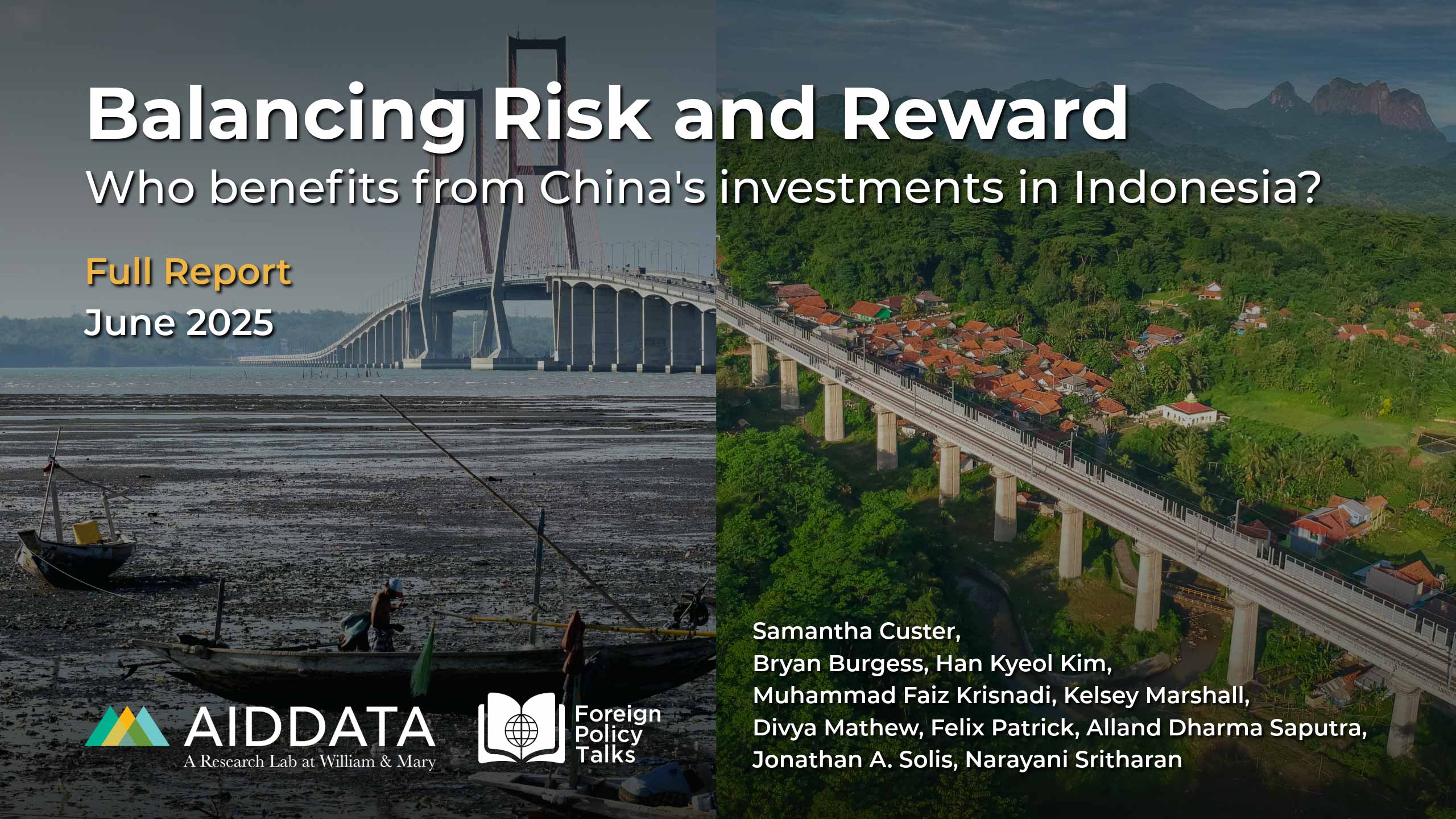
Balancing Risk and Reward:
Who benefits from China’s investments in Indonesia?
Samantha Custer, Bryan Burgess, Han Kyeol Kim, Muhammad Faiz Krisnadi, Kelsey Marshall, Divya Mathew, Felix Patrick, Alland Dharma Saputra, Jonathan A. Solis, Narayani Sritharan
June 2025
Acknowledgements
This report was prepared by Samantha Custer, Bryan Burgess, Han Kyeol Kim, Muhammad Faiz Krisnadi, Kelsey Marshall, Divya Mathew, Felix Patrick, Alland Dharma Saputra, Jonathan A. Solis, Narayani Sritharan. John Custer and Sarina Patterson supported this publication’s layout, editing, and visuals. The cover design is by Sarina Patterson, with photos of the Suramadu bridge (left) and the Jakarta–Bandung High-Speed Rail (right) by Dodo Hawe and Habib Farindra, respectively, via Adobe Stock, used under the Standard license. This study was conducted by AidData, a U.S.-based research lab at William & Mary’s Global Research Institute, in collaboration with Indonesia’s Foreign Policy Talks. We acknowledge Noto Suoneto for his helpful review and feedback, which strengthened the analysis and findings of this report. We thank the seven Indonesian experts from media, think tanks, government, civil society, and academia who graciously shared their insights via background interviews. This research was made possible with generous support from the United States Department of State. The findings and conclusions of this report are those of the authors alone and do not necessarily reflect the views of our funders and partners.
Citation
Custer, S., Burgess, B., Kim, H.K., Krisnadi, M.F., Marshall, K., Mathew, D., Patrick, F., Saputra, A.D., Solis, J.A., and N. Sritharan. (2025). Balancing Risk and Reward: Who benefits from China’s investments in Indonesia?. Williamsburg, VA: AidData at William & Mary.
Executive Summary
Chinese money has gone from a footnote to a headline in Indonesia’s growth trajectory since the early 2000s. Government agencies, state-owned enterprises, and private companies from China have invested large sums in Indonesia’s roads, power plants, and nickel factories. These financial infusions are erratic: big booms one year, sudden lulls the next. This report assesses the money, relationships, and outcomes from roughly two decades of PRC state-directed development finance and private foreign direct investment.
Money: What projects does the PRC finance, where, when—and why?
Beijing bankrolls ambitious, risky projects in Indonesia’s energy, transport, and extractives sectors that have the potential to generate commercial returns and advance BRI aspirations, while responding to domestic political priorities. The PRC pairs these investments with small-dollar goodwill projects in the social sectors. It deploys state resources strategically (US$69.6 billion in official finance from 2000 to 2023), constructing infrastructure and cultivating goodwill to crowd in market opportunities for Chinese FDI (US$94.1 billion from 2010 to 2024). Inbound investment from Chinese companies has outsized importance, representing one-quarter of new foreign capital expenditures.
As Indonesia’s largest supplier of development finance, Beijing operates more like a commercial lender than a traditional donor, issuing 90 percent of its financing as debt rather than aid. Among its ASEAN peers, Indonesia attracts more of both types of Chinese capital. Regions like Java and Sumatra capture the lion’s share of Beijing’s development finance in absolute terms, but resource-rich West Papua and Central Sulawesi stand out for attracting noticeably more of Beijing’s per capita spending.
Relationships: How many players, who are they, and what roles do they play?
Beijing’s development finance projects in Indonesia are not just made-in-China; they draw upon a global enterprise of 439 discrete entities from 35 countries. Fifty-eight Chinese state-owned policy and commercial banks, government agencies, and diplomatic missions were the primary financiers. These players relied on a multinational pool of 208 co-financiers across Asia, Europe, and North America to raise capital and distribute risk. Chinese state-owned enterprises (SOEs), 14 of whom were sanctioned for questionable financial practices, were the majority but not the totality of Beijing’s 213 implementers.
Just under half of the implementers of PRC projects were Indonesian, including stand-alone firms and participants in joint ventures and special purpose vehicles. Social sector projects capitalize on the credibility and distribution networks of Islamic organizations and universities in Indonesia to win hearts and minds. Six entities received large and frequent infusions of PRC financing, including the Government of Indonesia, Perusahaan Listrik Negara, Lembaga Pembiayaan Ekspor Indonesia, Bank Rakyat Indonesia, Garuda Indonesia, and two telecom companies, Smartel and Smartfren (subsidiaries of the Sinar Mas Group, recently merged with XL Axiata). Indonesian state-owned enterprises were often recipients of funding, but so too were powerful private sector conglomerates like the Bakrie Group (Bumi Resources, Bakrie Telecom, and Bakrie Autoparts) and subsidiaries of Chairul Tanjung’s CT Corp (Trans Retail Indonesia and Trans Media Corpora).
Outcomes: How does Beijing follow through and manage risk, and to what effect?
PRC-financed projects across Indonesia take an average of 2.5 years to move from funds committed to projects delivered, considerably slower than in ASEAN peers like the Philippines. Energy and transport projects are among the riskiest propositions: these activities trigger longer delivery delays (1,000+ days) and greater exposure to environmental and social risks. The choice of implementer is non-trivial, affecting project success and community well-being. Unfortunately, over 40 percent of Beijing’s development finance portfolio (US$30 billion) relied on risky implementers with higher levels of ESG exposure or prior sanctions for questionable business practices. Risky firms were often repeat implementers.
Beijing faces an uphill battle in converting money into reputational gains. Public approval of PRC leadership has soured in Indonesia as economic engagement with China increased. Public, private, and civil society elites attest to Beijing’s influence on domestic development priorities, but have grown more wary of this trend. The potential contribution of Chinese capital to Indonesia’s development has mixed results. Economically, provinces exposed to more Chinese FDI tended to have higher productivity, and those with more of Beijing’s development finance dollars had lower levels of unemployment. Worsening pollution and vegetation levels were not systematically linked to Chinese capital overall, but Indonesia’s Morowali Industrial Park showcases catastrophic impacts in individual projects. Finally, Indonesians may be redefining what it means for democracy to deliver: emphasizing economic development over political rights in ways that are conducive to Beijing’s preferred narratives and value proposition.